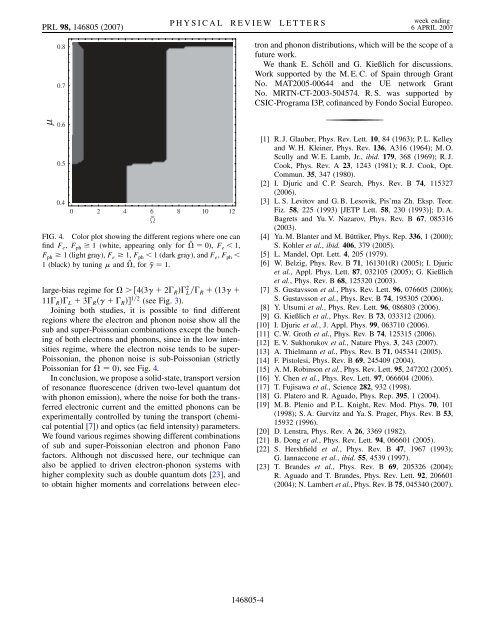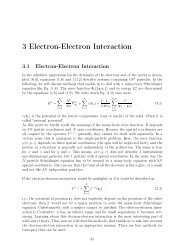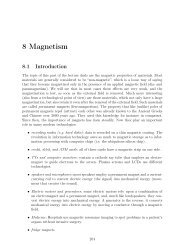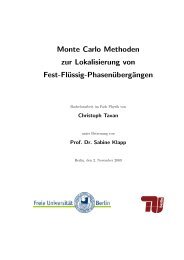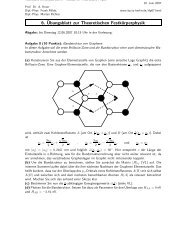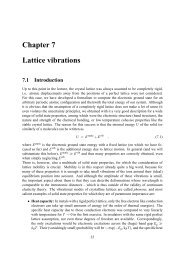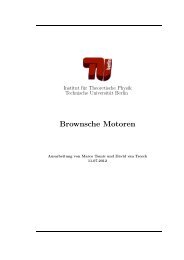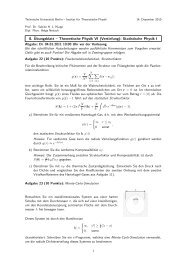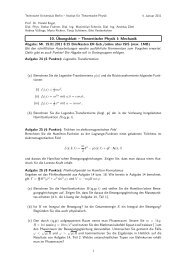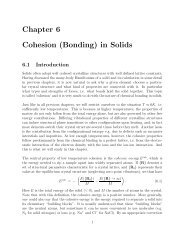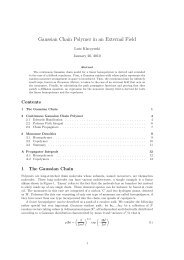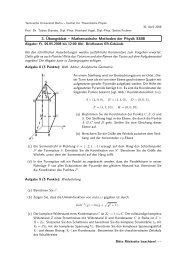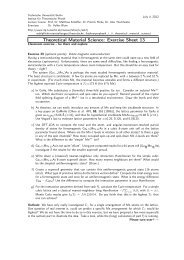Resonance Fluorescence in Transport through Quantum Dots ...
Resonance Fluorescence in Transport through Quantum Dots ...
Resonance Fluorescence in Transport through Quantum Dots ...
You also want an ePaper? Increase the reach of your titles
YUMPU automatically turns print PDFs into web optimized ePapers that Google loves.
PRL 98, 146805 (2007)<br />
0.8<br />
0.7<br />
PHYSICAL REVIEW LETTERS week end<strong>in</strong>g<br />
6 APRIL 2007<br />
large-bias regime for > 4 3 2 R<br />
2<br />
L = R 13<br />
11 R L 3 R R 1=2 (see Fig. 3).<br />
Jo<strong>in</strong><strong>in</strong>g both studies, it is possible to f<strong>in</strong>d different<br />
regions where the electron and phonon noise show all the<br />
sub and super-Poissonian comb<strong>in</strong>ations except the bunch<strong>in</strong>g<br />
of both electrons and phonons, s<strong>in</strong>ce <strong>in</strong> the low <strong>in</strong>tensities<br />
regime, where the electron noise tends to be super-<br />
Poissonian, the phonon noise is sub-Poissonian (strictly<br />
Poissonian for 0), see Fig. 4.<br />
In conclusion, we propose a solid-state, transport version<br />
of resonance fluorescence (driven two-level quantum dot<br />
with phonon emission), where the noise for both the transferred<br />
electronic current and the emitted phonons can be<br />
experimentally controlled by tun<strong>in</strong>g the transport (chemical<br />
potential [7]) and optics (ac field <strong>in</strong>tensity) parameters.<br />
We found various regimes show<strong>in</strong>g different comb<strong>in</strong>ations<br />
of sub and super-Poissonian electron and phonon Fano<br />
factors. Although not discussed here, our technique can<br />
also be applied to driven electron-phonon systems with<br />
higher complexity such as double quantum dots [23], and<br />
to obta<strong>in</strong> higher moments and correlations between electron<br />
and phonon distributions, which will be the scope of a<br />
future work.<br />
We thank E. Schöll and G. Kießlich for discussions.<br />
Work supported by the M. E. C. of Spa<strong>in</strong> <strong>through</strong> Grant<br />
No. MAT2005-00644 and the UE network Grant<br />
No. MRTN-CT-2003-504574. R. S. was supported by<br />
CSIC-Programa I3P, cof<strong>in</strong>anced by Fondo Social Europeo.<br />
µ<br />
0.6<br />
0.5<br />
0.4<br />
0 2 4 6 8 10 12<br />
FIG. 4. Color plot show<strong>in</strong>g the different regions where one can<br />
f<strong>in</strong>d F e , F ph 1 (white, appear<strong>in</strong>g only for ~ 0), F e < 1,<br />
F ph 1 (light gray), F e 1, F ph < 1 (dark gray), and F e , F ph <<br />
1 (black) by tun<strong>in</strong>g and ~ , for ~ 1.<br />
[1] R. J. Glauber, Phys. Rev. Lett. 10, 84 (1963); P. L. Kelley<br />
and W. H. Kle<strong>in</strong>er, Phys. Rev. 136, A316 (1964); M. O.<br />
Scully and W. E. Lamb, Jr., ibid. 179, 368 (1969); R. J.<br />
Cook, Phys. Rev. A 23, 1243 (1981); R. J. Cook, Opt.<br />
Commun. 35, 347 (1980).<br />
[2] I. Djuric and C. P. Search, Phys. Rev. B 74, 115327<br />
(2006).<br />
[3] L. S. Levitov and G. B. Lesovik, Pis’ma Zh. Eksp. Teor.<br />
Fiz. 58, 225 (1993) [JETP Lett. 58, 230 (1993)]; D. A.<br />
Bagrets and Yu. V. Nazarov, Phys. Rev. B 67, 085316<br />
(2003).<br />
[4] Ya. M. Blanter and M. Büttiker, Phys. Rep. 336, 1 (2000);<br />
S. Kohler et al., ibid. 406, 379 (2005).<br />
[5] L. Mandel, Opt. Lett. 4, 205 (1979).<br />
[6] W. Belzig, Phys. Rev. B 71, 161301(R) (2005); I. Djuric<br />
et al., Appl. Phys. Lett. 87, 032105 (2005); G. Kießlich<br />
et al., Phys. Rev. B 68, 125320 (2003).<br />
[7] S. Gustavsson et al., Phys. Rev. Lett. 96, 076605 (2006);<br />
S. Gustavsson et al., Phys. Rev. B 74, 195305 (2006).<br />
[8] Y. Utsumi et al., Phys. Rev. Lett. 96, 086803 (2006).<br />
[9] G. Kießlich et al., Phys. Rev. B 73, 033312 (2006).<br />
[10] I. Djuric et al., J. Appl. Phys. 99, 063710 (2006).<br />
[11] C. W. Groth et al., Phys. Rev. B 74, 125315 (2006).<br />
[12] E. V. Sukhorukov et al., Nature Phys. 3, 243 (2007).<br />
[13] A. Thielmann et al., Phys. Rev. B 71, 045341 (2005).<br />
[14] F. Pistolesi, Phys. Rev. B 69, 245409 (2004).<br />
[15] A. M. Rob<strong>in</strong>son et al., Phys. Rev. Lett. 95, 247202 (2005).<br />
[16] Y. Chen et al., Phys. Rev. Lett. 97, 066604 (2006).<br />
[17] T. Fujisawa et al., Science 282, 932 (1998).<br />
[18] G. Platero and R. Aguado, Phys. Rep. 395, 1 (2004).<br />
[19] M. B. Plenio and P. L. Knight, Rev. Mod. Phys. 70, 101<br />
(1998); S. A. Gurvitz and Ya. S. Prager, Phys. Rev. B 53,<br />
15932 (1996).<br />
[20] D. Lenstra, Phys. Rev. A 26, 3369 (1982).<br />
[21] B. Dong et al., Phys. Rev. Lett. 94, 066601 (2005).<br />
[22] S. Hershfield et al., Phys. Rev. B 47, 1967 (1993);<br />
G. Iannaccone et al., ibid. 55, 4539 (1997).<br />
[23] T. Brandes et al., Phys. Rev. B 69, 205326 (2004);<br />
R. Aguado and T. Brandes, Phys. Rev. Lett. 92, 206601<br />
(2004); N. Lambert et al., Phys. Rev. B 75, 045340 (2007).<br />
146805-4


